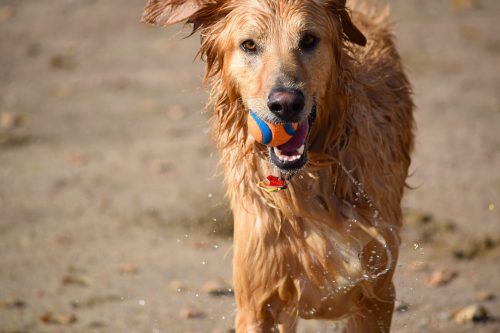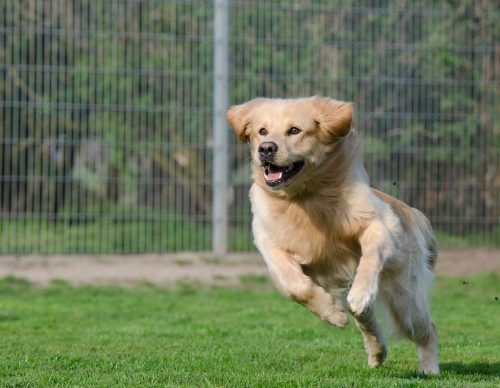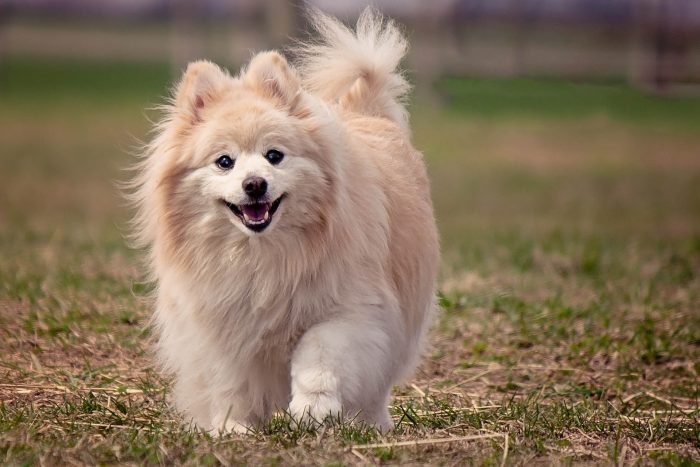Dogs bring out the best in people – warmth, happiness, friendship, unconditional love and playfulness. And they are happiest when running, jumping, digging, chasing balls and getting into mischief. They seem to have boundless energy. Many dog owners get more tired throwing a ball to their dog than their dog does sprinting after it.
Dogs seem to pay almost no attention to their body telling them it’s time to rest. When play time is over, they often pant for an hour, recovering from athletic output that would make professional athletes blush. Of course, not all dogs are that active. But all dogs love to play. And just like humans, a dog’s body breaks down over time – especially their joints.
Joint problems, including arthritis (long term joint issues) are very common in dogs. They range in severity from a slight annoyance to chronic pain and serious injuries that cause instability and can require surgery – like an ACL tear. Joint issues can happen at any time during your dog’s life, but are more common in older dogs with some physical mileage under their belts.
If your dog is experiencing joint pain, you will probably notice it, as he will limp or yelp in pain. Dogs, of course, cannot talk, so determining exactly what is bothering them can be difficult. The following information will help you learn about joint pain in dogs, and hopefully help you determine how to care for your dog if he does develop issues.
Causes of Dog Joint Pain
While there are many causes of joint pain in dogs, loss of joint cartilage is the main culprit. The rubber-like, elastic connective tissue covers and protects the joints in the legs of dogs. Cartilage is also a structural component in the nose, ears and ribcage.
Unlike skin and muscles, joint cartilage does not regenerate itself. Cartilage cells simply die after a certain period of time, which results in the cartilage thinning around the joints. When these cells die, they also release an enzyme that causes joints to swell known as joint inflammation. It’s a double-whammy of joint pain and inflammation.
When cartilage thins, the space between joint and bone narrows, which results in more pressure on the bone, and eventually, deterioration of the connective tissue.. As the bone deteriorates, it can create outgrowths called osteophytes. Degenerating cartilage leads to dysfunction of the joint, which can throw the body off balance and create additional issues down the line.
The thinning of cartilage is not a disease or illness. Sadly, it’s just part of getting older for both dogs and humans. But there are other conditions that can affect your dog’s joint health.
Developmental Disorders
Developmental disorders like hip and elbow dysplasia are common in dogs, and can cause severe joint pain. A healthy dog’s joints are perfectly functioning machines that require multiple bones, ligaments and cartilage to work together to allow the joint to move freely. If any part of the machine is misshapen, the entire system becomes flawed.
Hip and elbow dysplasia occur when an abnormal joint structure or laxity of muscle is present. These factors cause joint bones that normally touch each other to lose contact, and change size and shape. This process is called subluxation. Hip and elbow dysplasia can occur in one or both hips.
Dogs, cats and humans all suffer from hip dysplasia. Certain breeds of dogs – particularly large breeds – are most affected, including: German Shepherds, Labrador Retrievers, Rottweiler, Great Danes, Golden Retrievers, and Saint Bernard.
Small dogs suffer from degenerative diseases that create joint pain as well. Legg-Calve Perthes Disease affects small breeds like Miniature Poodles, Yorkshire Terriers, and West Highland White Terriers. This disease usually shows up in puppies. After three months, the dog’s joint will begin to deteriorate and eventually die, causing malformed hip joint and secondary arthritis.
Congenital Disorders
Some joint pain in dogs is caused by congenital disorders present at birth, including Wobbler’s Syndrome and luxated patella. Wobbler’s Syndrome is caused by a smaller than normal spinal canal within the dog’s vertebrae, which inhibits neural impulses and creates instability in the dog’s anatomy – including the joints. This disease is rare in most breeds, but Great Danes and Doberman Pinschers are often affected. Wobbler’s Disease is very serious, and can eventually lead to paralysis.
A “luxating patella” happens when the knee-cap bone is misshapen, and does not fit perfectly with the knee joint. When a dog is physically active, the patella can become dislodged from the joint. The kneecap eventually settles back into place, but does so by sliding across the bone, causing ongoing signs of pain for the dog – especially during activity.
Small breeds, including Miniature and Toy Poodles have the highest rates of luxated patella. Breeds with short legs, like Basset Hounds and Dachshunds, can also suffer from luxated patella due to their abnormal anatomical structure.
Fractures
Bone fractures, especially those occurring close to a dog’s joint, can lead to joint arthritis down the line. When a bone heals from a fracture, it rarely returns to its exact original shape. This can cause imbalance in the dog’s skeletal structure, which eventually affects the joints, as the body attempts to readjust to its new reality.
Ligament and Tendon Injuries
Injuries to a dog’s ligaments and tendons of the knee cause severe joint pain. The most common, and most serious, is a tear or rupture of the anterior cruciate ligament, better known as the ACL.
Anyone who watches or participates in sports is familiar with the dreaded ACL tear. It’s common in football, basketball and soccer players, and almost always requires surgery and a lengthy recovery period. ACL tears most often occur when a dog is running and changing directions quickly.
The femur and tibia are held together by the ACL and the PCL, or posterior cruciate ligament. When too much pressure it put on these ligaments, they can tear or completely rupture. The ACL is the more serious of the two injuries, but both can be damaging. When one or more ligaments rupture, the femur and tibia become untethered, and slide around loosely.
ACL injuries are painful. You will likely know something is seriously wrong if it happens to your dog. They will go lame in the affected leg, and yelp in pain. A veterinarian can normally diagnose an ACL tear through an examination of the joint, but an x-ray should be performed to determine if the dog requires surgery. Dogs who do require surgery will normally recover fully after a lengthy period of inactivity.
Hormonal Conditions
Some hormonal conditions, like hyperparathyroidism, can have an effect on a dog’s joints in a secondary manner. Dogs with hyperparathyroidism have an imbalance in calcium and phosphorus in their blood. The parathyroid gland, located at the base of the neck, regulates these levels, and when they are off-balance, the body takes calcium from the bone to compensate. This deteriorates the strength of the bone, leading to joint pain and inflammation problems.
Nutritional hyperparathyroidism, which occurs more frequently in puppies, can also lead to joint issues. All-meat diets can lead to an imbalance of calcium and phosphorus, similar to traditional hyperparathyroidism. The condition can be more serious in puppies, as their bones are underdeveloped. The good news is that changing your dog food or switching to a balanced diet can stop the condition in its tracks.
Cancer
There are various types of cancer found in dogs – including one that affects their joints. Synovial Sarcoma cancer affects the soft tissue around the joints of dogs. This cancer is aggressive and localized. A dog may start to limp around, lose weight, and lose his appetite prior to visible tumors.
As these tumors grow, they inhibit the dog’s ability to walk or run and result in pain as the tumor squeezes against the joints and bone. Synovial Sarcoma is rare in dogs, but when it does occur, swift and aggressive treatment is necessary to eradicate the tumor. As with all cancerous tumors, early detection is key for survival.
Osteoarthritis
Degenerative joint disease is the most common reason for joint pain over the long term, as it often is a symptom of various other issues, including those listed above – and including old age. In a nutshell, osteoarthritis happens when the cartilage breaks down, and the bones become exposed. The condition is progressive – it will continually get worse over time.
Depending on the age of the dog and the severity of the condition, there are treatments available to alleviate pain, including medication and even surgery. Though surgery is not common, emerging technologies are help vets to treat the condition through surgical measures more frequently. There is a lot of information on our blog about dog arthritis including dog arthritis symptoms, treatment, and medication options.
Lyme Disease
This tick-borne disease affects both humans and dogs. Lyme disease is most often contracted though deer ticks biting dogs and spreading the virus. Deer ticks are found in small numbers in various parts of the United States, but the majority of them are concentrated in the northeast from the Carolinas through southern Maine.
Lyme disease results in high fever, lameness, swollen lymph nodes – and joint inflammation. Unlike humans, who show symptoms of Lyme disease soon after a tick bite, dogs can take up to 2-5 months before exhibiting symptoms. Lyme disease in dogs can be treated with antibiotics for a period of 15-30 days. Flea and tick medications can help prevent dogs from contracting the disease.
Spinal Disease
Similar to degenerative joint diseases, spinal diseases like intervertebral disc disease can eventually cause joint pain in dogs. Like the ligaments in joints, vertebrae discs can cause atrophy from degenerative conditions, leading to herniation or ruptures. When they do, the structure of the dog’s spine is affected, and creates pain, loss of sensation, and even paralysis.
Joint health in the legs can fall victim to the domino effect, as the dog’s motor functions will change and potentially move the joints in a different manner than they are used to. It is difficult to determine why intervertebral disk disease occurs, but genetics play a factor. Certain breeds, including Dachshunds, Basset Hounds, Beagles, Cocker Spaniels, Shih Tzu, Lhasa Apsos, Pekingese, and Corgis have a greater incidence of disk disease.
Signs of Dog Joint Problems
As you can see, joint pain is quite common in dogs, and can be the result of a variety of factors. The specific reason your dog is having joint pain can be tough to determine. But recognizing that your dog has some type of chronic pain is easy. You will notice your dog having a difficult time with regular activities, like running, jumping up on the couch, climbing the stairs and even simple walking.
If the joint pain is more severe, you will notice your dog limping, holding up his affected leg, or even refusing to move at all. If the signs of joint pain are minor, make sure to monitor your dog closely over time to see if his condition deteriorates. If he seems to be getting progressively worse, take him to see a veterinarian to determine the underlying cause of the joint inflammation. Some joint pain is temporary, but if it lasts more than a week or so it is probably something more serious.
How to Avoid Canine Joint Problems
Joint problems are, unfortunately, a common part of life for both dogs and humans. Getting old is never easy. In many cases, there’s nothing you can do for your dog to prevent joint pain. But there are some things that you can do to reduce the likelihood that it will occur.
Weight management and diet: Obesity puts more pressure on a dog’s joints, increasing the likelihood of injury and overall wear and tear. Keeping your dog at a healthy weight through a proper diet and regular exercise will help avoid injury, help build muscle, and help mitigate pain when issues do occur.
Appropriate exercise: Dogs love to play. They love it so much, that they don’t know when to quit. Sometimes, it’s up to the dog owner to determine when enough is enough. Exercise is healthy and necessary for dogs. But over-activity can tax a dog’s joints, and increase the likelihood of issues.
Seek care: If you suspect that your dog has issues or pain in his joints, schedule an appointment with your vet. It’s never too early to treat joint pain in dogs. There are various medications such as anti-inflammatory drugs and other treatments that will help ease your dog’s chronic pain. Consult with your veterinarian to find the right treatment for your dog and their pain relief plan.








